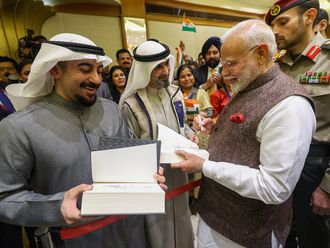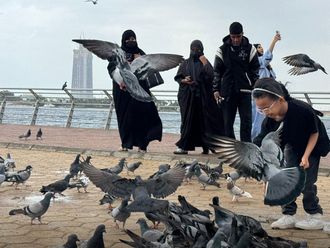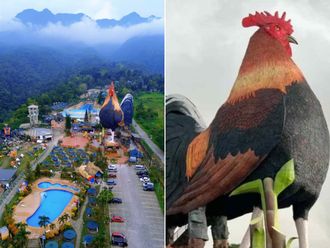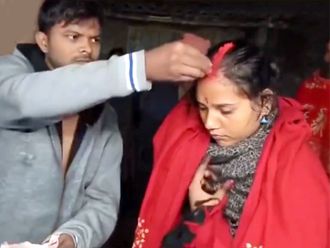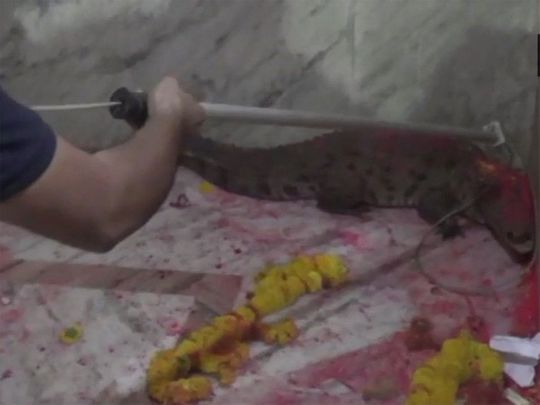
Devotees at the Khodiyar Mata temple in the Indian state of Gujarat had a surprise visitor yesterday, a crocodile. This was a miracle for the many worshippers of the temple’s deity, ‘Khodiya Mata’ or goddess Khodiyar whose mode of transport is believed to be a crocodile.
The crocodile attracted a large number of devotees after it strayed onto the premises of the temple in Gujarat’s Mahisagar district during the late hours of Sunday.
A video that went viral on social media showed the crocodile crawl into the sanctum sanctorum and sat there till the forest department came in to rescue the reptile.
Delay in rescue
The devotees allegedly caused a delay in the operation as they didn’t allow forest officials to rescue the crocodile. According to a report by Asian News International (ANI), Mahisagar’s Deputy Conservator of Forests R M Parmar said the people assembled at the temple delayed rescue operations by around two hours. “When our personnel reached there to rescue the crocodile, people opposed it. We waited for two hours as we did not want to hurt religious sentiments. However, later, we managed to get the reptile to a nearby pond,” Parmar added.
R V Patel, Range Forest Officer of the Mahisagar forest department said: “The crocodile is a giant one, it weighs 17kgs and is 6 feet long. We had a hard time rescuing it as a large number of devotees started worshipping the crocodile. Another problem that we faced while rescuing the crocodile was that the sanctum sanctorum was small in comparison to the crocodile. We have now released him into a nearby pond.”
Social media reacts
The video went viral and Indian news media outlets shared the story. Twitter users jumped in to react. While some said the crowd frenzy was unacceptable and the reptile should be rescued soon, others continued to call it a miracle.
@saurabh_singh27 tweeted: “What are they feeding the crocodile? Care should be taken for its rehabilitation and not let it die in crowd frenzy.”
Meanwhile, @kdramafanin questioned: “Are they serious? What if it harmed someone?”
Crocodile worship
Khodiyar Mata, the deity of the Patel community in the state, is often depicted in religious literature as riding on a crocodile.
According to R V Patel: “A large number of people who had assembled at the Khodiyar Temple... offered prayers, conducted prayer rituals and showered vermillion on the 6-foot reptile as it lay near the goddess’ idol.”
Many Hindu castes, especially the Leva Patels worship the Khodiyar Maa as the ‘Kuldevi’ or family deity. But crocodile worship is not unique to them. Crocodiles are worshipped in a number of different cultures.
Other instances in India
In January an entire village in the Indian state of Chhattisgarh, mourned the death of a crocodile, whom they used to worship as their protector. For residents of the Bawa Mohtara village in Bemetara district, the around 130-year-old crocodile, whom they had fondly named as ‘Gangaram’, was extremely sacred.
After the reptile died in a village pond, grief-stricken residents took out its funeral procession and did not cook food that day.
In Kerala, a crocodile named Babiya guards the famous Ananthapura Lake Temple. According to an article on the Indian news website Indiatimes.com: “Legend has it that Babiya is a local guardian of the temple. Babiya only eats the temple prasad, which is made of rice and jaggery and does not harm anyone, including the fish in the lake. The crocodile is believed to be vegetarian and has been guarding the temple for more than 60 years.”
In Goa, a village worships crocodiles for bountiful crop yields. Annually, residents of Adulshem celebrate a peculiar agrarian cultural expression dedicated to crocodile worship. They make a dummy crocodile out of silt extracted from the land as villagers chant prayers for a better crop and fish yield.
Karachi’s crocodile shrine
Crocodiles play an important role in one of Karachi, Pakistan’s oldest Sufi shrines as well.
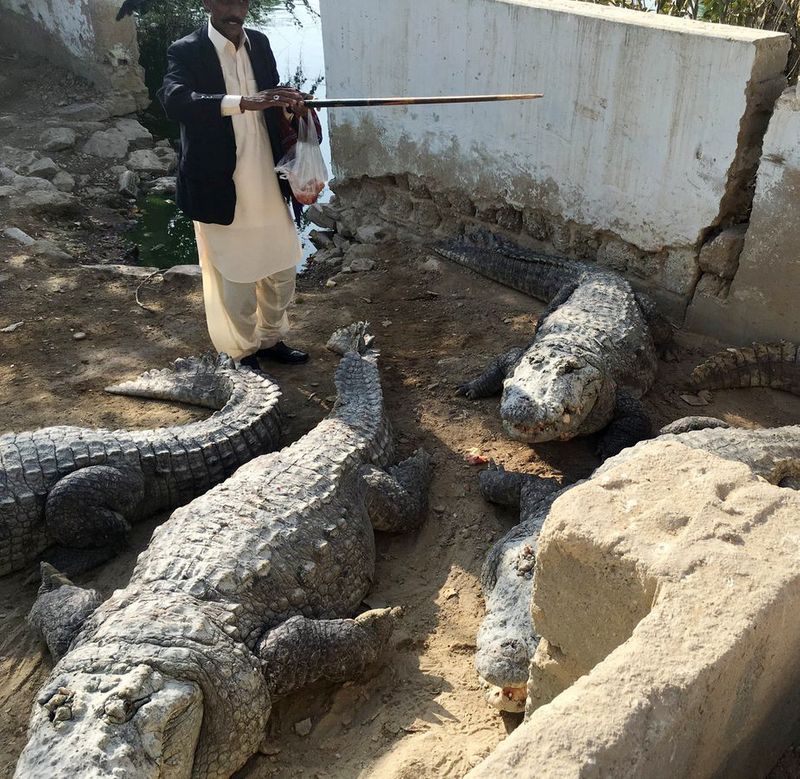
Haji Syed Shaikh Sultan who is more popularly known as Mangho Pir was a Sufi saint in Sindh, given the title of ‘Pir’ or saint by Baba Farid, a Punjabi Muslim preacher and mystic.
Located in present day Karachi, Mangho Pir’s shrine attracts many. The same name was also given to the area. While Sindh is known for being a sanctuary for many mystics of the past, the shrine of Mangho Pir features something very special – a pond full of crocodiles.
The reptiles are an essential part of the bustling ambience of the centuries-old shrine.
As hundreds flock to the resting place of the saint every day, visitors make sure to feed the crocodiles that are subject to many myths.
While it’s unclear what exactly is the link the reptiles had with the saint or how they got there, there are plenty of speculations by the locals.
Whatever the origin of the reptiles getting to Mangho Pir may be, one thing is clear, the visitors treat them with high regard.
The crocodiles are seen sunbathing in the water as visitors feed them with meat as well as Pakistani sweets like Halwa.
Many believe that the saint belonged to the Sheedi also known as the Makrani community, who have African heritage.
Every year, members of the ethnic group gather at Mangho Pir and celebrate a festival called the Sheedi Mela. According to a report by English-language Pakistani newspaper, The Daily Times, at the festival, the elders of this community call out the heaviest and biggest crocodiles from the pond. Once the reptiles are out, assigned caretakers feed them sweets and meat, as well as shower and adorn them with red roses.
Once the crocodile eats the meat and raises its neck above the ground, it is believed that the ritual has been completed and the offerings have been accepted by the creature.
Crocodile conservation in India
Crocodiles are Schedule 1 animals (provided absolute protection) as per the Indian Wildlife (Protection Act), 1972.
The Indian gharial (Gavialis Gangeticus), a close relative of the mugger crocodile, has been on the International Union for Conservation of Nature (IUCN) red list for decades due to its rapidly declining population.
Once found in abundance in all rivers of India, this fish-eating reptile is now limited to just a few rivers. In 1975, the Indian Crocodile Conservation Project was set up with the support of the Government of India, initially in the Satkosia Gorge Sanctuary in the Indian state of Odisha. The project was implemented with the financial aid of the United Nations Development Fund and Food and Agriculture Organisation. A gharial breeding center was built in Nandankanan Zoological Park.
A male gharial was flown in from Frankfurt Zoological Garden to become one of the founding animals of the breeding program. In subsequent years, several protected areas were established.
In December 2010, the then Indian Minister for Environment and Forests, Jairam Ramesh announced the formation of a National Tri-State Chambal Sanctuary Management and Coordination Committee for gharial conservation along the Chambal River in Madhya Pradesh, Rajasthan and Uttar Pradesh.
According to an article in the Indian news magazine, India Today: “Due to extensive conservation efforts by wildlife departments in Rajasthan, Madhya Pradesh, Uttar Pradesh and the relatively undisturbed riverine ecosystem of the Chambal which passes through these three states, gharial numbers have reached over 1,680 in the Chambal Sanctuary area.”
And, according to the website of the famous Ranthambore National Park: “With the initiation of Crocodile Conservation Project, 4000 gharial/aligator, 1800 mugger/crocodile and 1500 saltwater crocodiles could be restocked.”





